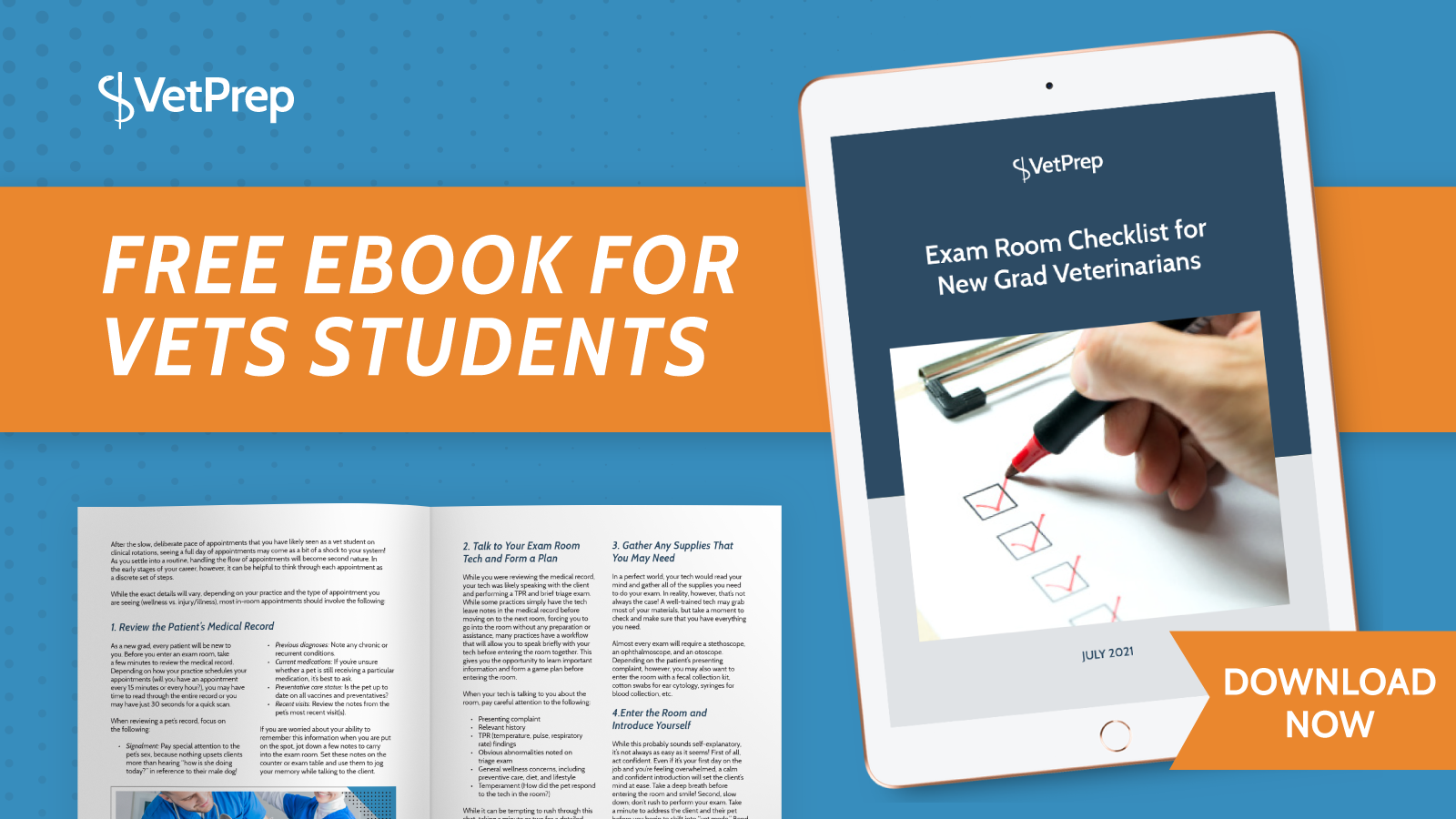
![]() Depending on what sort of practice you enter after vet school, you may find yourself performing as many as 30 physical exams per day. While that may seem daunting, I promise you will adjust.
Depending on what sort of practice you enter after vet school, you may find yourself performing as many as 30 physical exams per day. While that may seem daunting, I promise you will adjust.
However, given how many exams you will be performing, it pays to get good at them. All of your valuable medical knowledge will be worth very little if you can’t perform a thorough physical exam in an efficient manner.
When thinking about how to tackle your in-room physical exams, remember the following three tips:
1. Set the patient at ease
Making the physical exam enjoyable for your patient can have a number of benefits. Obviously, dealing with a patient that is calm and relaxed will make the experience more pleasant for both you and the client. More importantly, however, you can get more information from a relaxed pet. Have you ever tried to palpate the abdomen of a tense, fearful dog or cat? If so, you probably quickly realized that you could not feel very much! Now compare that to the experience of palpating a calm and relaxed patient. Your exam will be more informative if your patient is calm.
There are many different strategies for keeping patients calm during their veterinary visits. What works in one setting may not work in another setting.
In general, though, the following ideas can help you:
- Try to remain calm. In the rush of a busy day, it’s easy to enter an exam room looking and feeling frazzled. While this is obviously less than ideal from your client’s perspective, it can also have an impact on your patients. Take a deep breath before entering an exam room and try to be as non-anxious as possible, even if that feels easier said than done!
- Use treats liberally. Both dogs and cats often respond well to treats! Not only can you offer treats upon first entering the room, to help win the pet over, but you can also have the client or your tech administer treats during the exam or any unpleasant handling that you may need to perform.
- Use Feliway® for feline patients. The pheromones present in Feliway diffusers and sprays can make a big difference in your cat patients’ anxiety levels. Consider using diffusers in your cat exam rooms and spraying Feliway on your clothing at the beginning of the day.
- Use low-stress handling techniques when possible. There are entire courses dedicated to helping veterinary professionals work with pets in lower-stress ways. Focusing on these methods can decrease your patients’ stress levels associated with veterinary visits, allowing you to get more from your physical exams.
Remember that every patient you see will likely return for a future visit. Taking your time and making today’s visit less stressful will likely pay off in future visits.
2. Use a systematic approach
Many veterinarians use a nose-to-tail approach for their physical exams. While there’s no rule that states you must go in this exact order, it’s important to get into some sort of routine. Routines help ensure that nothing is missed and you don’t have to waste time asking “what’s next?” or “did I remember to…?”
If you use the nose-to-tail approach, here’s a general order you may use for your exam:
- Examine the head, including the eyes, ears, and mouth
- Check the peripheral lymph nodes
- Auscult the heart and lungs
- Palpate the spine and the skin along the body
- Palpate the abdomen
- Check the hips and hindlimbs
- Check the tail, rectum, and genitals
There is some debate over whether every physical exam should include a rectal exam. Many veterinarians argue that it should because a rectal exam can be a valuable tool for identifying prostatic enlargement, anal sac issues, neoplasia, and other illnesses. Other veterinarians, however, argue that a rectal exam can be uncomfortable and stressful for patients and therefore should only be performed if indicated. Personally, I tend to only perform a rectal exam on intact male dogs or other pets in which I have reason to suspect an issue, but I will leave that issue for you to research so you can make your own decisions.
3. Explain everything to the client
While performing your exam, verbalize your findings to the client. Explain what you’re doing, even if it’s just a simple explanation like “I’m feeling his abdominal organs and everything feels good.” This approach has a number of benefits. Explaining the process and calling attention to what you are doing helps the clients see value in the physical exam and learn more about their pet’s health. Additionally, verbalizing your findings can improve your exam room efficiency, by decreasing the amount of explanation that you need to provide the client when recapping your findings after your exam.
It Gets Easier
When I first started performing physical exams in front of clients, it was definitely a bit intimidating! I felt comfortable in my ability to perform an exam, but doing so with a client audience added a whole new level of challenge. As my caseload increased, learning to be more efficient in my exams presented a whole new challenge.
Fortunately, it gets easier with practice! With time, you will become better at juggling the “customer service” aspects of the exam with the medical aspects of the exam, making your job easier and allowing you to be more efficient in the exam room.



